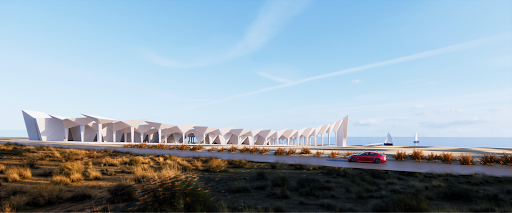
By challenging the notion of a solid boundary between the natural and artificial, Desert Feather Fall introduces a fresh atmosphere to the semi-desert landscape in the heart of the Baja California peninsula, Mexico. This pavilion design exemplifies the seamless integration of human-made structures with the inherent beauty of nature, achieved through a modular approach.
The pavilion finds its ideal location between the transpeninsular highway and the beach, prioritizing accessibility as a fundamental aspect of its design. Pathways from both the highway and a nearby pier extend towards the seaside, transforming the pavilion into an iconic landmark that can be admired and reached from both land and sea.
Although the final architecture is visually stunning and captivating, the design process posed challenges due to the vast natural surroundings. As an experienced architectural designer, Liu had to skillfully avoid creating a solid, monolithic structure that would sharply contrast with the environment.
In order to instill a sense of lightness to the design, Liu discerned the optimal potential in modular design. Along with her collaborator Tianyu Wang, they drew inspiration from the uninterrupted rhythm and flow of layered feathers aligning with the wind currents during flight. This concept metamorphosed into a cohesive roof structure and is partitioned into a grid of modules, each featuring bi-directional apertures optimized to channel light and ventilation effortlessly throughout the pavilion.
To further preserve visual openness of the space, Liu and Wang implemented a face-to-point design technique to the elevation, which effectively decreased the sense of volume of the building while granting visitors the unique privilege of glimpsing the sea from any location within the structure.
Beneath the expansive roof, an assemblage of pliable, module-based clusters come to life, each manifesting versatility in shape and purpose. Ingeniously interconnected at roof vertices, these modules elegantly transit in base size - from slender to substantial, from sparse to compact - opening up a myriad of possibilities for diverse spaces.
Additionally, Liu introduced a lighthouse at the forefront of the building and made the apex of the lighthouse the highest point of the entire roof surface. The altering heights and form variation of the modules imbue the structure with a feather-like lightness and fluidity, resonating with the rhythmic undulation of falling feathers and effortlessly merging the built structure with its natural surroundings.
Going beyond mere aesthetics, The Feather Fall pavilion is intended to instill a sense of reverence, facilitating spaces for reflection and introspection. It crafts a space that visually and functionally pulses with dynamic energy while maintaining a commitment to sustainable design, which is something that Liu always looks to achieve.









